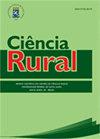Risk factors associated with stillbirth in sows
IF 0.9
4区 农林科学
Q3 AGRONOMY
引用次数: 1
Abstract
ABSTRACT: In this study, the risk factors associated with stillbirth in sows were identified and their odds ratio assessed. For this purpose, 587 farrowings on Farm A and 929 on Farm B were monitored, and the sow parity, body condition score, farrowing duration, total number of piglets born, numbers of live births, stillbirths, and mummified piglets, obstetric interventions, and piglet sex and weight were recorded. At the end of farrowing, piglets classified as stillborn were necropsied to confirm the diagnosis. Consequently, 5.49% of the piglets on Farm A and 5.10% of those on Farm B were stillborn. On both farms, sows with a high parity, prolonged farrowing, and a large litter size had the highest odds ratio of stillbirths. On Farm B, farrowing intervention through the use of vaginal palpation and oxytocin increased the odds of stillbirth by 1.7 and 2.5 times, respectively. Heavy litters increased the odds of stillbirth by 1.4 times. Additionally, low-birth-weight piglets were 2.3 and 3.1 times more likely than their medium-birth-weight and high-birth-weight counterparts, respectively, to be stillborn. In conclusion, on both farms, the risk factors associated with stillbirth were a high parity, a large litter size, and prolonged farrowing.与母猪死产相关的危险因素
摘要:本研究确定了母猪死产的相关危险因素,并评估了它们的优势比。为此,我们对A农场的587只小猪和B农场的929只小猪进行了监测,记录了母猪胎次、体况评分、分娩持续时间、产仔总数、活产仔数、死胎仔数和干尸仔数、产科干预措施以及仔猪性别和体重。在分娩结束时,对归类为死产的仔猪进行尸检以确认诊断。因此,A场5.49%的仔猪和B场5.10%的仔猪为死产。在这两个农场中,胎次高、分娩时间长、产仔量大的母猪死产的几率最高。在B农场,通过使用阴道触诊和催产素进行分娩干预,死产的几率分别增加了1.7倍和2.5倍。胎重使死产的几率增加了1.4倍。此外,低出生体重仔猪的死产率分别是中等出生体重仔猪和高出生体重仔猪的2.3倍和3.1倍。总之,在这两个养殖场,与死产相关的危险因素是胎次高、产仔量大和分娩时间长。
本文章由计算机程序翻译,如有差异,请以英文原文为准。
求助全文
约1分钟内获得全文
求助全文
来源期刊

Ciencia Rural
AGRONOMY-
CiteScore
1.70
自引率
0.00%
发文量
233
审稿时长
2-4 weeks
期刊介绍:
The purpose of Ciência Rural is to publish the results of original research, note and reviews which contribute significantly to knowledge in Agricultural Sciences. Preference will be given to original articles that develop news concepts or experimental approaches and are not merely repositories of scientific data. The decison of acceptance for publication lies with the Editors and is based on the recommendations of Editorial Comission, Area Committee and/ or ad hoc reviewers. The editors and reviewers are external to the institution.
 求助内容:
求助内容: 应助结果提醒方式:
应助结果提醒方式:


